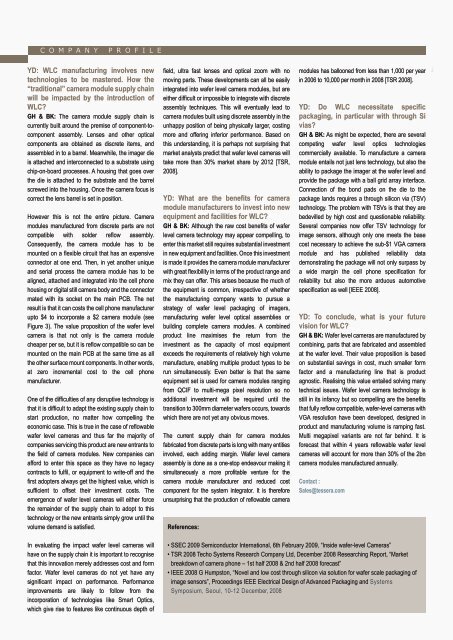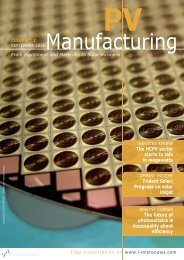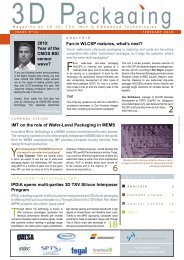3M & SUSS announce agreement on temporary wafer ... - I-Micronews
3M & SUSS announce agreement on temporary wafer ... - I-Micronews
3M & SUSS announce agreement on temporary wafer ... - I-Micronews
You also want an ePaper? Increase the reach of your titles
YUMPU automatically turns print PDFs into web optimized ePapers that Google loves.
J U L Y 2 0 0 9 i s s u e n ° 1 1<br />
N e w s l e t t e r o n 3 D I C , T S V , W L P & E m b e d d e d T e c h n o l o g i e s<br />
C O M P A N Y P R O F I L E<br />
Printed <strong>on</strong> recycled paper<br />
YD: WLC manufacturing involves new<br />
technologies to be mastered. How the<br />
“traditi<strong>on</strong>al” camera module supply chain<br />
will be impacted by the introducti<strong>on</strong> of<br />
WLC?<br />
GH & BK: The camera module supply chain is<br />
currently built around the premise of comp<strong>on</strong>ent-tocomp<strong>on</strong>ent<br />
assembly. Lenses and other optical<br />
comp<strong>on</strong>ents are obtained as discrete items, and<br />
assembled in to a barrel. Meanwhile, the imager die<br />
is attached and interc<strong>on</strong>nected to a substrate using<br />
chip-<strong>on</strong>-board processes. A housing that goes over<br />
the die is attached to the substrate and the barrel<br />
screwed into the housing. Once the camera focus is<br />
correct the lens barrel is set in positi<strong>on</strong>.<br />
However this is not the entire picture. Camera<br />
modules manufactured from discrete parts are not<br />
compatible with solder reflow assembly.<br />
C<strong>on</strong>sequently, the camera module has to be<br />
mounted <strong>on</strong> a flexible circuit that has an expensive<br />
c<strong>on</strong>nector at <strong>on</strong>e end. Then, in yet another unique<br />
and serial process the camera module has to be<br />
aligned, attached and integrated into the cell ph<strong>on</strong>e<br />
housing or digital still camera body and the c<strong>on</strong>nector<br />
mated with its socket <strong>on</strong> the main PCB. The net<br />
result is that it can costs the cell ph<strong>on</strong>e manufacturer<br />
upto $4 to incorporate a $2 camera module (see<br />
Figure 3). The value propositi<strong>on</strong> of the <strong>wafer</strong> level<br />
camera is that not <strong>on</strong>ly is the camera module<br />
cheaper per se, but it is reflow compatible so can be<br />
mounted <strong>on</strong> the main PCB at the same time as all<br />
the other surface mount comp<strong>on</strong>ents. In other words,<br />
at zero incremental cost to the cell ph<strong>on</strong>e<br />
manufacturer.<br />
One of the difficulties of any disruptive technology is<br />
that it is difficult to adapt the existing supply chain to<br />
start producti<strong>on</strong>, no matter how compelling the<br />
ec<strong>on</strong>omic case. This is true in the case of reflowable<br />
<strong>wafer</strong> level cameras and thus far the majority of<br />
companies servicing this product are new entrants to<br />
the field of camera modules. New companies can<br />
afford to enter this space as they have no legacy<br />
c<strong>on</strong>tracts to fulfil, or equipment to write-off and the<br />
first adopters always get the highest value, which is<br />
sufficient to offset their investment costs. The<br />
emergence of <strong>wafer</strong> level cameras will either force<br />
the remainder of the supply chain to adopt to this<br />
technology or the new entrants simply grow until the<br />
volume demand is satisfied.<br />
In evaluating the impact <strong>wafer</strong> level cameras will<br />
have <strong>on</strong> the supply chain it is important to recognise<br />
that this innovati<strong>on</strong> merely addresses cost and form<br />
factor. Wafer level cameras do not yet have any<br />
significant impact <strong>on</strong> performance. Performance<br />
improvements are likely to follow from the<br />
incorporati<strong>on</strong> of technologies like Smart Optics,<br />
which give rise to features like c<strong>on</strong>tinuous depth of<br />
field, ultra fast lenses and optical zoom with no<br />
moving parts. These developments can all be easily<br />
integrated into <strong>wafer</strong> level camera modules, but are<br />
either difficult or impossible to integrate with discrete<br />
assembly techniques. This will eventually lead to<br />
camera modules built using discrete assembly in the<br />
unhappy positi<strong>on</strong> of being physically larger, costing<br />
more and offering inferior performance. Based <strong>on</strong><br />
this understanding, it is perhaps not surprising that<br />
market analysts predict that <strong>wafer</strong> level cameras will<br />
take more than 30% market share by 2012 [TSR,<br />
2008].<br />
YD: What are the benefits for camera<br />
module manufacturers to invest into new<br />
equipment and facilities for WLC?<br />
GH & BK: Although the raw cost benefits of <strong>wafer</strong><br />
level camera technology may appear compelling, to<br />
enter this market still requires substantial investment<br />
in new equipment and facilities. Once this investment<br />
is made it provides the camera module manufacturer<br />
with great flexibility in terms of the product range and<br />
mix they can offer. This arises because the much of<br />
the equipment is comm<strong>on</strong>, irrespective of whether<br />
the manufacturing company wants to pursue a<br />
strategy of <strong>wafer</strong> level packaging of imagers,<br />
manufacturing <strong>wafer</strong> level optical assemblies or<br />
building complete camera modules. A combined<br />
product line maximises the return from the<br />
investment as the capacity of most equipment<br />
exceeds the requirements of relatively high volume<br />
manufacture, enabling multiple product types to be<br />
run simultaneously. Even better is that the same<br />
equipment set is used for camera modules ranging<br />
from QCIF to multi-mega pixel resoluti<strong>on</strong> so no<br />
additi<strong>on</strong>al investment will be required until the<br />
transiti<strong>on</strong> to 300mm diameter <strong>wafer</strong>s occurs, towards<br />
which there are not yet any obvious moves.<br />
The current supply chain for camera modules<br />
fabricated from discrete parts is l<strong>on</strong>g with many entities<br />
involved, each adding margin. Wafer level camera<br />
assembly is d<strong>on</strong>e as a <strong>on</strong>e-stop endeavour making it<br />
simultaneously a more profitable venture for the<br />
camera module manufacturer and reduced cost<br />
comp<strong>on</strong>ent for the system integrator. It is therefore<br />
unsurprising that the producti<strong>on</strong> of reflowable camera<br />
References:<br />
modules has ballo<strong>on</strong>ed from less than 1,000 per year<br />
in 2006 to 10,000 per m<strong>on</strong>th in 2008 [TSR 2008].<br />
YD: Do WLC necessitate specific<br />
packaging, in particular with through Si<br />
vias?<br />
GH & BK: As might be expected, there are several<br />
competing <strong>wafer</strong> level optics technologies<br />
commercially available. To manufacture a camera<br />
module entails not just lens technology, but also the<br />
ability to package the imager at the <strong>wafer</strong> level and<br />
provide the package with a ball grid array interface.<br />
C<strong>on</strong>necti<strong>on</strong> of the b<strong>on</strong>d pads <strong>on</strong> the die to the<br />
package lands requires a through silic<strong>on</strong> via (TSV)<br />
technology. The problem with TSVs is that they are<br />
bedevilled by high cost and questi<strong>on</strong>able reliability.<br />
Several companies now offer TSV technology for<br />
image sensors, although <strong>on</strong>ly <strong>on</strong>e meets the base<br />
cost necessary to achieve the sub-$1 VGA camera<br />
module and has published reliability data<br />
dem<strong>on</strong>strating the package will not <strong>on</strong>ly surpass by<br />
a wide margin the cell ph<strong>on</strong>e specificati<strong>on</strong> for<br />
reliability but also the more arduous automotive<br />
specificati<strong>on</strong> as well [IEEE 2008].<br />
YD: To c<strong>on</strong>clude, what is your future<br />
visi<strong>on</strong> for WLC?<br />
GH & BK: Wafer level cameras are manufactured by<br />
combining, parts that are fabricated and assembled<br />
at the <strong>wafer</strong> level. Their value propositi<strong>on</strong> is based<br />
<strong>on</strong> substantial savings in cost, much smaller form<br />
factor and a manufacturing line that is product<br />
agnostic. Realising this value entailed solving many<br />
technical issues. Wafer level camera technology is<br />
still in its infancy but so compelling are the benefits<br />
that fully reflow compatible, <strong>wafer</strong>-level cameras with<br />
VGA resoluti<strong>on</strong> have been developed, designed in<br />
product and manufacturing volume is ramping fast.<br />
Multi megapixel variants are not far behind. It is<br />
forecast that within 4 years reflowable <strong>wafer</strong> level<br />
cameras will account for more than 30% of the 2bn<br />
camera modules manufactured annually.<br />
C<strong>on</strong>tact :<br />
Sales@tessera.com<br />
• SSEC 2009 Semic<strong>on</strong>ductor Internati<strong>on</strong>al, 6th February 2009, “Inside <strong>wafer</strong>-level Cameras”<br />
• TSR 2008 Techo Systems Research Company Ltd, December 2008 Researching Report, “Market<br />
breakdown of camera ph<strong>on</strong>e – 1st half 2008 & 2nd half 2008 forecast”<br />
• IEEE 2008 G Humpst<strong>on</strong>, “Novel and low cost through silic<strong>on</strong> via soluti<strong>on</strong> for <strong>wafer</strong> scale packaging of<br />
image sensors”, Proceedings IEEE Electrical Design of Advanced Packaging and Systems<br />
Symposium, Seoul, 10-12 December, 2008<br />
8
















